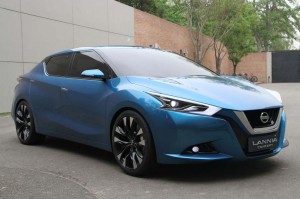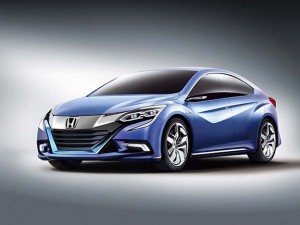Japanese carmakers came to the big auto show in Beijing this year determined to show they are prepared to fight for the hearts and minds of Chinese customers.
Struggling to regain momentum lost due to an ongoing debate between China and Japan over a chain of uninhabited, but strategically located, islands, Toyota, Nissan, Honda and other Japanese makers rolled out an assortment of new models they hope will help them close the gap with more established players in the huge Chinese car market, notably including Volkswagen AG and General Motors.
One of the most significant introductions came from Lexus, which unveiled the new Lexus NX utility vehicle, the long-anticipated production version of a controversial concept vehicle, then called the LF-NX first unveiled during the Frankfurt Auto Show last autumn.
(Jeep debuts four new Beijing concepts – and announces plans to produce three models in China. Click Here for the story.)
The Lexus NX tones down some of the wildest design details of the show car but maintains an unusually aggressive design language for a brand traditionally known for its more plain vanilla styling language. That reflects the demands of Toyota CEO Akio Toyoda to inject, more “wakudoki,” or passion, into the company’s products.

Nissan is targeting the Lannia Concept towards the "balinghou," the post-'80s generation that's grown up in an increasingly propserous China.
Meanwhile, the new NX will be offered with three powertrain options: a naturally aspirated gas engine, an optional hybrid powertrain, or a higher-performance turbo package – the first time Lexus has used a turbo in its line-up.
Yale Zhang, an independent analyst who keeps an eye on the Chinese market, said Chinese consumers are buying more and more utility vehicles as the market in China continues to expand . But Lexus faces some stiff competition for sales as 20 different luxury brands have staked a claim to the Chinese market.
(Is this the new BMW flagship? Click Here to check out the maker’s distinctive Beijing concept vehicle.)
Lexus rival Acura, for example exhibited a hybrid version of flagship RLX hybrid at the Beijing Auto Show. The RLX can be ordered with a new, gas-electric version of the Acura Sport Hybrid SH-AWD which pairs a 3.5-liter V-6 gasoline engine with three electric motors, one driving the front wheels, the others powering the back.
Acura is billing the new system as a way to improve both fuel economy and performance at the same time. For one thing, it allows the use of torque vectoring where the outer wheels receive more power to assist the car to turn through sharp corners.
The electric version of its SH-AWD system will also be used in the MDX utility vehicle and the upcoming NSX supercar.

Honda also is aiming at young buyers with the Concept B - which should reach the Chinese market in about two years.
Honda also had a new hybrid to show off in Beijing, the Concept B. The prototype is a 5-door model developed exclusively for the Chinese market. Painted in an eye-popping purple, its aimed at a relatively youthful audience and, as has been the case with a number of recent Honda show cars, the maker says a mass-production model based on the show car is already underway, with its Chinese team taking the lead. Expect to see the production version of the Concept B reach the market in two years, according to Honda executives.
(Lincoln reveals new MKX Concept in Beijing. Click Here for a closer look.)
Nissan used the Beijing show to debut the Lannia Concept, which is its latest sedan concept aimed specifically at China’s rising “Post-80s” generation, the “balinghou.”
The concept is the second model to be borne from Nissan’s design center in China, which opened its new studio in 2013. It features signature trademarks of Nissan’s next generation design, including the V-motion grille, boomerang headlamps, a distinctive kick-up pillar, as well as a “floating” roof.
Taiji Toyota, head of Nissan Design China, says the Lannia Concept exudes “daqi” — a Chinese word that is hard to define but has the strength to push people to aspire towards better things.
Zhang noted that Japanese automakers have been gradually losing market share in China’s rapidly expanding market to American and European manufacturers. Poltical tension between the two traditional rivals worsened the situation over the last several years, but the clash was only part of the story.
Investments by Japanese carmakers have not kept pace with the rapid development of the Chinese market, leaving makers like Nissan without sufficient production capacity to keep pace. Even if the Japanese carmakers began adding capacity today it probably wouldn’t be ready for another three years, warned Zhang.
Nonetheless, Japanese carmakers seems strongly upbeat during their Beijing previews.
Honda announced plans to add research and development capacity in China, while Mazda said it expects sales in the booming market to grow by 18% this year. In fact, Mazda sales surged 22% during the first quarter of 2014.
During the press day at the Beijing Show, Mazda showed Chinese versions of the Mazda6 and Mazda3, which were equipped with the company’s SkyActiv technology. Chinese customers have been waiting for the technology, which saves fuel, boosts power and reduces the weight of key components, Mazda officials insisted.
If Mazda hits it target, it will soon be selling almost twice as many vehicles in China as it does in the United States.
(Click Here to check out TheDetroitBureau.com’s complete NY Auto Show coverage.)

